MXA’S 2014 SUZUKI RM-Z250 MOTOCROSS TEST: A VERY GOOD BIKE THAT COULD BE A GREAT BIKE WITH A LITTLE TLC AT THE FACTORY
FIRST AND FOREMOST, IS THE 2014 RM-Z250 BETTER THAN THE 2013 RM-Z250?
A: Yes, but not resoundingly so. We are mildly happy to get any changes at all. The Japanese manufacturer did very little to improve the latest edition of the RM-Z250, instead relying on a product that was introduced in 2013. Still, the MXA wrecking crew admits that the 2014 RM-Z250 is incredibly good, even if it’s roughly only 5 percent better than last year.
Q: HOW MANY CHANGES WERE MADE TO THE 2014 SUZUKI RM-Z250?
A: You won’t need to take your shoes and socks off to count the number of changes made to the 2014 Suzuki RM-Z250. In fact, you can count the changes on one hand.
(1) ECU.
Although there is much confusion about how it works or what it does—we have recieved two different verisons of the same story from Suzuki. Let’s just say—that Suzuki’s engineers mapped the ECU to not light off the spark plug on the exhaust stroke when the kickstarter is used. Once the RM-Z250 engine begins to run on its own, the ignition returns to the conventional dual-spark system. What’s the benefit of this “single-fire spark” programming? It lessens kickback when the RM-Z250 doesn’t start. Previously, it was possible for the spark on the exhaust stroke to light off excess fuel in the combustion chamber and cause the engine to kick back as the leftover gases expanded. This wreaked havoc on the engine, kickstarter gears and—what you care about most—your leg. Suzuki effectively eliminated delayed combustion. On the other hand—there is a completely different explanation. Either way, this is not earth shattering stuff. In fact, it is something you will never notice and it doesn’t improve performance once the bike is running.
(2) Aesthetics.
The plastic scheme is generally the same, aside from the yellow side panels that have replaced the white units from last year. The RM-Z250 also receives BNG (Bold New Graphics), which are the spitting image of last year’s motif (with gray and black accents instead of red and black).
Railing: The RM-Z250 boasts the best cornering in the class. It’s a hoot to ride.
Q: WHAT CHANGES DO WE WISH SUZUKI WOULD HAVE MADE TO THE RM-Z250 FOR 2014?
A: It’s hard to knock a bike that is so well equipped in stock trim; however, there are several annoying flaws that we would like Suzuki to address.
(1) Clutch.
The clutch system cannot handle the load of the engine. At the very least, Suzuki should install stiffer clutch springs.
(2) Hot-start lever.
Suzuki is the only manufacturer to still use a hot-start lever, and the plastic lever will break the first time you tip the RM-Z250 over.
(3) Overheating.
Trade the stock 1.1 kpf radiator cap for a higher-pressure cap (www.cvproducts.com) to prevent the RM-Z250 from boiling over.
(4) Bolts.
Maybe it’s just us, but we round off more Suzuki bolts than all the other brands combined.
Q: HOW FAST IS THE 2014 SUZUKI RM-Z250 ENGINE?
Perky: The RM-Z250 has a solid, race-inspired engine package.
A: The answer depends on the rider; however, all skill levels agree that the RM-Z250 engine is a winner.
Beginners, Novices and Vets: The meaty power is more than enough to catapult a rider of this level to faster lap times and improved performance. The RM-Z250 is relatively easy to ride. Flubbing a corner isn’t a death sentence.
Intermediates and Experts: You might think that because the RM-Z250 is perfect for slow riders it wouldn’t be sufficient for highly skilled throttle twisters. Wrong! The good spread of power caters to those who live above 10,000 rpm. It’s true that the RM-Z250 will lose ground to the Kawasaki KX250F, Yamaha YZ250F and KTM 250SXF, but the Suzuki is much easier to keep on the pipe than the 250SXF. And, with the addition of the lean coupler, an adept rider will have no trouble sticking with the green and orange bikes.
Numbers: Suzuki has figured out the frame geometry formula.
Q: WHAT SECRET TUNING TRICK DO YOU NEED TO KNOW ABOUT THE RM-Z250?
A: It takes 30 seconds to change the power characteristics of the RM-Z250—and it is free. Does this sound too good to be true? Suzuki provides each 2014 RM-Z250 owner with two optional mapping couplers, aside from the stock (white) coupler. Confusingly, Suzuki includes another white coupler. Here’s the breakdown:
Lean coupler (white):
It’s easy to differentiate the lean coupler from the stock coupler, although they share the same hue. Simply locate the back of the coupler. If you see wires extending out of one plug location and returning to another, then you’ve found the lean coupler. The stock coupler doesn’t have any wiring. Every MXA test rider preferred the lean, aggressive coupler. It added punch to the powerband. The lean coupler was the shock of energy that brought Frankenstein’s monster to life.
Rich coupler (gray):
An excellent choice for dry and hardpack tracks, the rich coupler detunes the engine to prevent wheelspin. It is not a smart choice in loam or heavy soil, but it works great if you’re riding on the moon.
Go in: Most testers preferred to crank in on the SFF preload.
Q: HOW DOES THE 2014 SUZUKI RM-Z250 RUN ON THE DYNO?
A: We were surprised to discover that our 2014 RM-Z250 gained some horsepower at peak over the 2013 model. Not only that, but the 2014 averaged almost a horsepower better than last year’s bike throughout the power curve. The 2014 RM-Z250 amassed 39.23 ponies at 12,200 rpm, with 19.79 foot-pounds of torque. In comparison, the 2013 engine hit 38.01 ponies at 19.29 foot-pounds of torque.
Q: WHAT IS THE GREATEST ATTRIBUTE OF THE 2014 SUZUKI RM-Z250?
A: Suzuki has done a masterful job of reaching perfection in two key areas of motorcycle development.
(1) Cornering.
The RM-Z250 has long held the distinction of being the best-cornering bike in its class. The twin-spar aluminum chassis is a marvel, but that’s not all. It’s becoming popular among bike manufacturers to take handling to the extreme by pulling in the head angle and putting a greater emphasis on front-end weight bias. Not Suzuki. They have discovered the magical frame geometry formula. Yes, the RM-Z250 suffers from headshake, but straight-line stability improves once the bike is set up properly.
Fight and flight: The RM-Z250 is a potent weapon through corners, thanks to a powerful engine. It’s equally as good in the air, thanks to a lightweight chassis and comfortable ergonomics.
(2) Engine.
The seat-of-the-pants dyno is more accurate than the mechanical one. And while it’s true that the RM-Z250 produces less peak horsepower than the KTM 250SXF (41.92 ponies), Yamaha YZ250F (42.5 horses) and Kawasaki KX250F (40.614 ponies), there is not that obvious a power difference under race conditions. Why? The RM-Z250 powerband is broad and fruitful. It has a modest amount of over-rev to satisfy those who refuse to shift and carries speed from gear to gear.
Q: WHAT DID WE DO TO IMPROVE THE 2014 SUZUKI RM-Z250?
A: Find success by making these modifications to the 2014 Suzuki RM-Z250.
(1) Couplers.
We heartily recommend that you conduct your own test session by trying out the optional couplers provided by Suzuki at every track you frequent.
(2) Clutch.
The clutch cannot handle the rigors of a serious clutch abuser. Even riders who play nice with the RM-Z250 clutch will benefit from stiffer clutch springs.
(3) Exhaust system.
The restricted muffler on the RM-Z250 is a disservice to the engine. We’ve had good luck with a myriad of aftermarket exhaust systems.
(4) Steering stem.
As with the Honda CRF250, don’t be afraid to crank down on the steering-stem bearings. When slack, the front end of the RM-Z250 tends to wander at higher speeds, leading to headshake.
2014 Suzuki RM-Z250: It’s hard to rag on a bike received minimal changes because it was so good last year. There was only one slight engine modification, while the others were for aesthetics.
Q: WHAT DO WE HATE?
A: The hate list:
(1) Updates.
We aren’t pleased that Suzuki rested on its laurels and didn’t invest R&D money into an RM-Z250 revision. There are obvious flaws that could have been easily fixed (see below).
(2) Clutch.
Just like a Kardashian marriage, the RM-Z250 clutch fades quickly and cannot stand the test of time.
(3) Hot start.
It breaks with regularity and looks like a hobbit’s toe.
(4) Bolts.
Suzuki has the 8mm head-bolt market cornered, with the possible exception of Fisher-Price. The RM-Z250 bolts are pitiful.
Q: WHAT DO WE LIKE?
A: The like list:
(1) Handling.
Cornering prowess is the RM-Z250’s best attribute. It can hit lines that other bikes can only dream of making.
(2) Engine.
It’s not the fastest or easiest powerband in the class, but it’s broad and powerful enough to get the job done. The job? Winning.
(3) Couplers.
Want more hit? Plug in the white coupler. Want to prevent the rear tire from lighting up like a paper factory next to a volcano? Plug in the gray coupler.
(4) Suspension.
The Showa SFF forks and piggyback shock do a decent job. Don’t confuse these SFF forks with the atrocious ones on the RM-Z450. The little bike’s forks are workmanlike. Not so with the big bike’s forks.
Q: WHAT DO WE REALLY THINK?
A: In truth, Suzuki didn’t have much choice but to release a rebadged RM-Z250 for 2014. They spent most of the pre-pro R&D season under bankruptcy protection—and spending money is a no-no when you have a judge looking through your books. Luckily, the RM-Z250 was such a good bike in 2013 that it can endure benign neglect in 2014. The shame is that with a few small changes, 2014 could very well have been the year that the Suzuki RM-Z250 reclaimed top honors in the 250 class. Even so, its still on the short list of bikes that we would buy.
MXA’S 2014 SUZUKI RM-Z250 SETUP SPECS
This is how we set up our 2014 Suzuki RM-Z250 for racing. We offer it as a guide to help you get your own bike dialed in.
SHOWA SFF FORK SETTINGS

Suzuki equipped the RM-Z250 with Showa’s Separate Function forks (SFF) in 2013. We were pleased with them last year, and Suzuki kept the single-spring design for 2014. The forks are stout enough for heavier and faster riders but might be too stiff for lighter and slower riders. Don’t be afraid to play with oil height and preload. We discovered that cranking in on the preload yielded a better overall feel.
For hardcore racing, these are MXA’s recommended 2014 Suzuki RM-Z250 fork settings (when changed, stock settings are in parentheses):
Spring rate:
0.99 kg/mm
Oil quantity:
340cc in right leg
Compression:
8 clicks out (11 clicks out)
Rebound:
12 clicks out (9 clicks out)
Preload:
6 clicks out
Fork-leg height:
Flush with top clamp
Notes:
The RM-Z250 is very sensitive to fork tube height. We found that running the forks flush with the top triple clamp balanced the suspension and lessened headshake. We also tightened the steering stem to prevent excessive headshake. Note that when the forks are new, they need about an hour of ride time before they properly break in.
SHOWA SHOCK SETTINGS
For hardcore racing, these are MXA’s recommended 2014 Suzuki RM-Z250 shock settings (when changed, stock settings are in parentheses):
Spring rate:
5.5 kg/mm
Race sag:
105mm
Hi-compression:
1-1/2 turns out (2 turns out)
Lo-compression:
12 clicks out (14 clicks out)
Rebound:
12 clicks out (14 clicks out)
Notes:
The shock takes about an hour to break in. Continue to check the sag until the shock is completely broken in. Don’t discount the shock when it comes to handling. If the shock is too stiff or the race sag insufficient, the RM-Z250 can go from a sweet-handling machine to a yellow ogre. Balance the front and rear with careful setup.


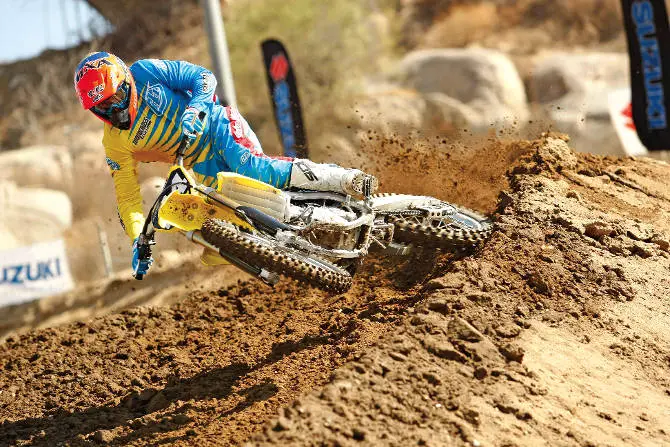
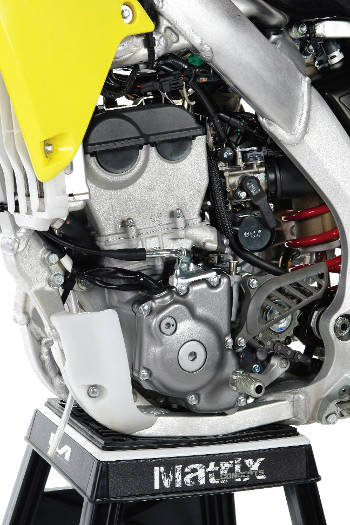

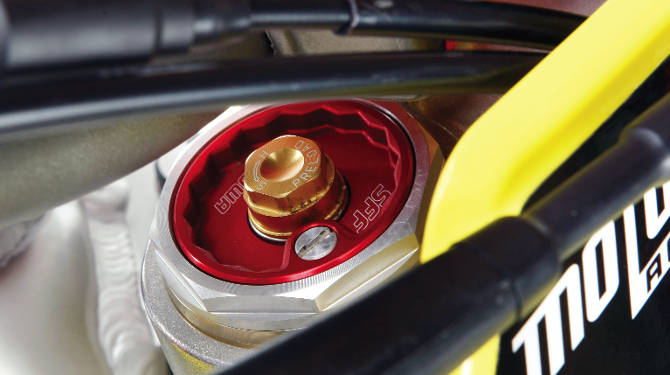
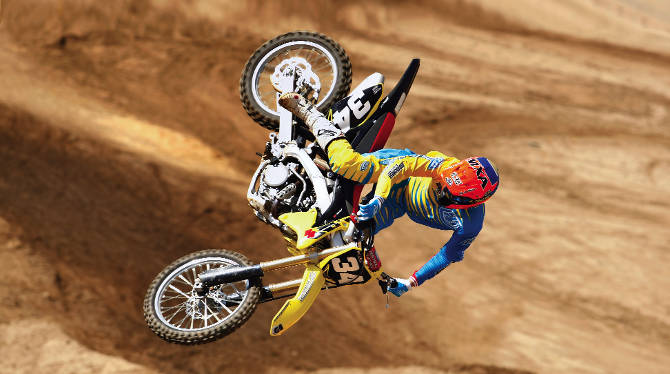

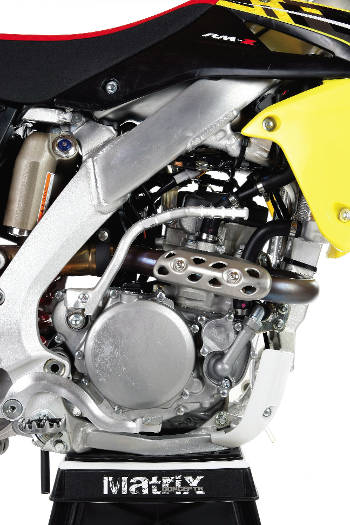

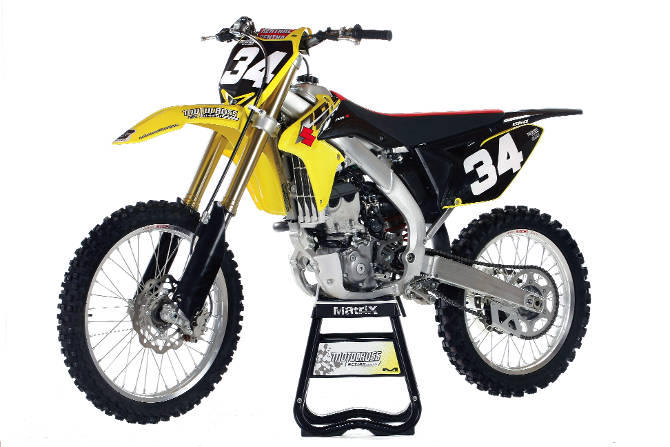


Comments are closed.